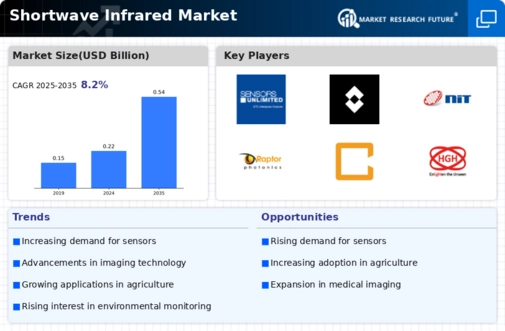Shortwave Infrared Size
Shortwave Infrared Market Growth Projections and Opportunities
The Shortwave Infrared (SWIR) market is influenced by a myriad of factors that collectively shape its dynamics and growth trajectory. One of the primary market drivers is the increasing demand for SWIR technology in various applications, spanning industries like healthcare, manufacturing, defense, and agriculture. The ability of SWIR technology to penetrate through certain materials and provide valuable insights makes it a versatile solution for different sectors.
Technological advancements play a crucial role in propelling the Shortwave Infrared market forward. Ongoing research and development efforts result in the enhancement of SWIR sensors, making them more sensitive, cost-effective, and efficient. As these technological improvements continue, the market is likely to witness a surge in adoption, with industries seeking to leverage the benefits of enhanced imaging and sensing capabilities offered by SWIR technology.
Moreover, the market is significantly influenced by regulatory factors and government policies. Policies favoring the adoption of SWIR technology in defense and surveillance applications contribute to market growth. Additionally, government initiatives supporting the use of SWIR in agriculture for monitoring crop health and optimizing yield act as catalysts for market expansion. The regulatory landscape, therefore, plays a pivotal role in shaping the overall market environment for SWIR technology.
Global economic conditions also impact the Shortwave Infrared market. Economic stability and growth contribute to increased investments in research and development, fostering technological innovation in the SWIR sector. Conversely, economic downturns may lead to a slowdown in investments, affecting the pace of technological advancements and market expansion. Understanding and adapting to these economic factors are crucial for businesses operating in the SWIR market to navigate uncertainties and capitalize on opportunities.
The competitive landscape is another market factor that shapes the dynamics of the SWIR market. The presence of key players, their market share, and strategies such as mergers, acquisitions, and partnerships influence the overall competitiveness. Companies that invest in developing cutting-edge SWIR solutions and establishing strong market presence are likely to have a significant impact on market growth. Innovation, pricing strategies, and the ability to meet evolving customer demands are key determinants of success in this competitive market.
End-user industries also contribute to the market's growth. For instance, the demand for SWIR technology in the healthcare sector for medical imaging applications is driven by the need for improved diagnostics. Similarly, industries like manufacturing and automotive utilize SWIR sensors for quality control and inspection processes. The diversified applications across various sectors underscore the broad market potential of Shortwave Infrared technology.
Environmental factors, such as climate change and natural disasters, can also influence the SWIR market. The technology's utility in disaster management, environmental monitoring, and remote sensing positions it as a valuable tool in addressing challenges related to climate change and natural calamities. As global awareness of environmental issues grows, the demand for SWIR technology in these applications is likely to increase.












Leave a Comment